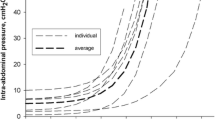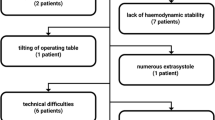Abstract
Introduction
Many studies have reported on the effects of pneumoperitoneum in a rat model, using a wide range of intra-abdominal pressures. The correlation between pneumoperitoneal pressures in rodents to pressures in humans has not been established. This study evaluates changes in various physiological parameters in different pneumoperitoneum pressures in the rat model with a comparison to known data in humans.
Materials and methods
Three groups of eight Wistar rats each were anesthetized, tracheostomized, and mechanically ventilated with fixed tidal volume and respiratory rate. After a stabilization phase, CO2 pneumoperitoneum was established to 12, 8, and 5 mmHg in the different groups. Changes in blood pressure, heart rate, peak ventilatory pressure, and end-tidal CO2 (ETCO2) were recorded throughout the experiment.
Results
There were no significant changes in blood pressure and heart rate in all groups. No increase in ETCO2 was demonstrated following induction of pneumoperitoneum in the 12 and 8 mmHg groups. A statistical significant increase in ETCO2 occurred only in the 5 mmHg group (39.4 to 41.3 mmHg, p = 0.023).
Ventilatory pressures increased after induction of pneumoperitoneum in all groups. The increase reached a maximal level in the 8 and 12 mmHg groups (from 3 to 12 mmHg) and was lower in the 5 mmHg group (from 3 to 7 mmHg)
Conclusions
The neglected increase in ETCO2 in pressures ≥8 mmHg, in the rat correlates to high pressures in humans (above 14–20 mmHg) when CO2 diffusion through the peritoneum declines due to pressure occlusion of peritoneal capillaries.
The maximal ventilatory pressures generated in the rat in intra-abdominal pressures ≥8 mmHg correlate to pressures, which are higher than the standard working pressures in humans.
Thus, pneumoperitoneal pressures >8 mmHg in the rat do not simulate routine working pressures employed in humans. A pressure of 5 mmHg is optimal in a rat model to simulate laparoscopy in humans.




Similar content being viewed by others
References
Dalton M, Hildreth J, Matsuoka T, Berguer R (1996) Determination of cardiorespiratory function and the optimum anesthetic regimen during laparoscopic surgery in the rat model. Surg Endosc 10(3):297–300
Hopkins MP, Dulai RM, Occhino A, Holda S (1999) The effects of carbon dioxide pneumoperitoneum on seeding of tumor in port sites in a rat model. Am J Obstet Gynecol 181(6):1329–1333
Kuntz C, Wunsch A, Bodeker C, Bay F, Rosch R, Windeler J, Herfarth C (2000) Effect of pressure and gas type on intraabdominal, subcutaneous, and blood pH in laparoscopy. Surg Endosc 14(4):367–371
Hazebroek EJ, Haitsma JJ, Lachmann B, Steyerberg EW, de Bruin RW, Bouvy ND, Bonjer HJ (2002) Impact of carbon dioxide and helium insufflation on cardiorespiratory function during prolonged pneumoperitoneum in an experimental rat model. Surg Endosc 16(7):1073–1078
Strobel O, Wachter D, Werner J, Uhl W, Muller CA, Khalik M, Geiss HK, Fiehn W, Buchler MW, Gutt CN (2006) Effect of a pneumoperitoneum on systemic cytokine levels, bacterial translocation, and organ complications in a rat model of severe acute pancreatitis with infected necrosis. Surg Endosc 20(12):1897–1903
Imamoglu M, Cay A, Unsal MA, Aydin S, Ozdemir O, Karahan C, Sari A, Sarihan H (2006) The effects of increased intraabdominal pressure on testicular blood flow, oxidative stress markers, and morphology. J Pediatr Surg 41(6):1118–1124
Rosch R, Stumpf M, Junge K, Drinjakovic D, Schachtrupp A, Afify M, Schumpelick V (2005) Influence of pneumoperitoneum on small bowel anastomoses: a histological analysis in the rat model. J Invest Surg 18(2):63–69
Yol S, Bostanci EB, Ozogul Y, Zengin NI, Ozel U, Bilgihan A, Akoglu M (2004) Effect of carbon dioxide pneumoperitoneum on the severity of acute pancreatitis: an experimental study in rats. Surg Endosc 18(12):1747–1751
Nakada H, Ishida H, Hashimoto D, Mori T, Hosono M (2005) Influence of different pneumoperitoneal pressures on tumor cell distribution in rats. Surg Endosc 19(4):563–568
Barbaros U, Ozarmagan S, Erbil Y, Bozbora A, Cakar N, Eraksoy H, Kapran Y, Kiran B (2004) Effects of pneumoperitoneum created through CO2 insufflation and parameters of mechanical ventilation (PEEP application) on systemic dissemination of intraabdominal infections. Surg Endosc 18(3):501–507
Magno R, Medegard A, Bengtsson R et al (1970) Acid base balance during laparoscopy: The effect of intraperitoneal insufflation of carbon dioxide and nitrous oxide on acid-Base balance during controlled ventilation. Acta Obstet Gynecol Scand 58:81–85
Wolf JS Jr (1996) Pathophysiologic effects of prolonged laparoscopic operation. Semin Surg Oncol 12:86–95
Goldman JM (1987) A simple, easy, and inexpensive method for monitoring ETCO2 through nasal canulae. Anesthesiology 67:606
Girardis M, Broi UD, Antonutto G, Pasetto A (1996) The effect of laparoscopic cholecystectomy on cardiovascular function and pulmonary gas exchange. Anesth Analg 83(1):134–140
Blobner M, Bogdanski R, Jelen-Esselborn S, Henke J, Erhard W, Kochs E (1999) Visceral resorption of intra-abdominal insufflated carbon dioxide in swine. Anasthesiol Intensivmed Notfallmed Schmerzther 34(2):94–99
Blobner M, Felber AR, Gogler S et al (1993) The resorption of carbon dioxide from the pneumoperitoneum in laparoscopic cholecystectomy. Anaesthesist 42(5):288–294
Safran DB, Orlando R III (1994) Physiologic effects of pneumoperitoneum. Am J Surg 167(2):281–286
Rauh R, Hemmerling TM, Rist M, Jacobi KE (2001) Influence of pneumoperitoneum and patient positioning on respiratory system compliance. J Clin Anesth 13(5):361–365
Hirvonen EA, Poikolainen EO, Pääkkönen ME, Nuutinen LS (2000) The adverse hemodynamic effects of anesthesia, head-up tilt, and carbon dioxide pneumoperitoneum during laparoscopic cholecystectomy. Surg Endosc 14(3):272–277
Meier C, Contaldo C, Schramm R, Holstein JH, Hamacher J, Amon M, Wanner G, Trentz O, Menger MD (2007) A new model for the study of the abdominal compartment syndrome in rats. Surg Res 139(2):209–216
Author information
Authors and Affiliations
Corresponding author
Rights and permissions
About this article
Cite this article
Avital, S., Itah, R., Szomstein, S. et al. Correlation of CO2 pneumoperitoneal pressures between rodents and humans. Surg Endosc 23, 50–54 (2009). https://doi.org/10.1007/s00464-008-9862-7
Received:
Revised:
Accepted:
Published:
Issue Date:
DOI: https://doi.org/10.1007/s00464-008-9862-7




